 Woburn Sands Area Bottles
Woburn Sands Area Bottles 
After picture postcards, local bottles are the most sought-after collectables. These are the examples I have found so far:
The Swan Hotel
I have two examples of flagons from the Swan Hotel. Both are marked “T. GREGORY, SWAN HOTEL, WOBURN SANDS”. The first 1/2 gallon was made by Skey in Tamworth, but the handle has broken off. This was found buried under a hedge in Hardwick Road (along with a bed frame and an old bicycle) when the hedge was removed to re-align the gardens. The other is a miniature flagon, just 11cm tall, also with the handle broken, and George Skey, Wilnecote, Tamworth makers mark. This would have been used to take spirits or port wine home from the Hotel bar. Thomas Gregory was at the Swan between 1896 and 1903, and I believe ran “The Royal Engineer” at Wolverton before this, where he also had flagons with his name on.
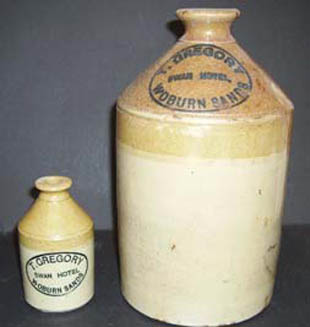
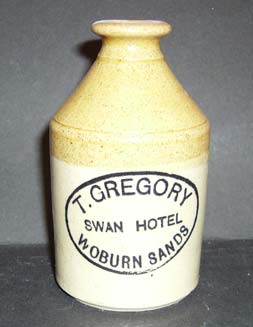
Down & Needham
The full story of Down & Needham can be found on another page on this website. They were wine and spirit dealers who were also agents for Phipps Brewery in Northampton, and then also branched out into running a few pubs. Their premises at the top of Russell Street were known as “The Eagle Malting”, and is still a wine and spirit merchants today. Both the examples of flagon I have seen read “DOWN & NEEDHAM WINE & SPIRIT MERCHANTS WOBURN SANDS” and are printed in blue, which is quite unusual. There is a 1/4 gallon size, with the blue print on face of flagon, and also a 1/2 gallon size with the blue print on a white background on the shoulder of the flagon. Both made by Buchan, Portobello Edinburgh. Very few examples of these blue print flagons still exist, I know of six in total.
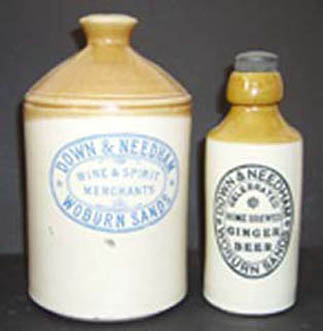
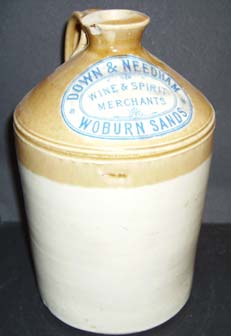
Down and Needham also produced a ginger beer bottle, marked “DOWN & NEEDHAM CELEBRATED HOME BREWED GINGER BEER WOBURN SANDS” It comes in the standard two-tone colour, with an internal screw stopper marked “DOWN & NEEDHAM WOBURN SANDS”. The bottles were made by Bourne, Denby. Unlike the flagons, the print on these is black.
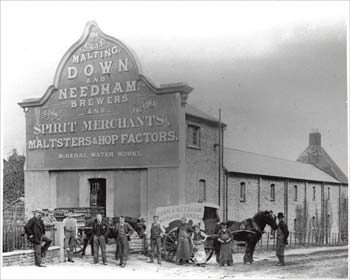
There are many glass bottles from Down & Needham. I believe that William Needham was producing his own mineral waters first, before going into partnership with Frederick Down, after the death of Frederick’s brother and business partner, Henry, in 1891. Therefore, the bottles embossed with only an “N” on the base were from the Needham-only era, and others with “D&N” on the base must have come later. Frederick Down then died in 1902, so it was a fairly short partnership, but they had time to branch out with a bottling premises near Bedford bridge, over the River Ouse, and several other outlets in local towns. Codd-style bottles can be identified by their marble stopper. The Codd bottle was filled upside down, so that as soon the filling stopped, the marble fell down against a rubber washer to seal the bottle. Pressure inside the bottle kept the marble pressed against the top of the bottle. To open the bottle, the marble was pushed in, where it would fall into the neck chamber below. If the opened bottle is held the right way, the marble is held inside the neck chamber when the bottle is tilted up for pouring. Many of these bottles were destroyed once empty, as children would routinely break open the bottle to get at the marble inside! This closure device was invented by Hirram Codd, and patented in 1872. It also gave us the English slang term “Coddswallop” for talking rubbish, as real beer drinkers considered these non-alcoholic beverages to be useless, as the contents were just a load of “Coddswallop!”. Coloured glass versions, or those with coloured marbles, can command extremely high prices, but all the Woburn Sands varieties are plain glass, sometimes called aqua, although they can have a slightly green tinge.
Here are large and small size versions of a codd bottle marked “WOBURN SANDS MINERAL WATER WORKS”. It has a large “N” on the base. The large size also has the number “9966”, while the smaller has the number 10012. WOBURN SANDS arches over the top, MINERAL WATER is across the middle, and WORKS arched under the bottom. There is also an example of the smaller size that was re-used by another firm, who etched their details, “MARSOM, NORTHILL” onto the rear. Recycling is nothing new!
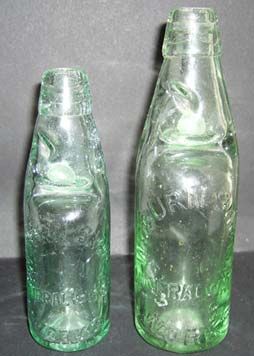
Then there are large and small versions of “THE WOBURN SANDS AERATED WATER COMPY” codd. The text is in a circle around two pointers and a central spot, looking a bit like a compass, or a clock with the hands at 6 o’clock. There is a Niagara patent on back of the bottle.
The same text and design features on the only Hamilton-style bottles from Woburn Sands. The larger is one of three found in a cellar in Leighton Buzzard a few years ago. The torpedo-shape bottle was patented in 1809 by William Hamilton of Dublin. The curved bottom had the advantage of forcing the user to lie it on its side to keep the liquid in constant contact with the cork and thereby preventing it from drying out and allowing air in to spoil the contents; its shape allowed it to be much stronger than conventional flat bottom bottles of equal weight, so it was less likely to crack or break under pressure of the carbonation; it is also hard to set down an opened bottle till you finished the contents, so customers drank faster!
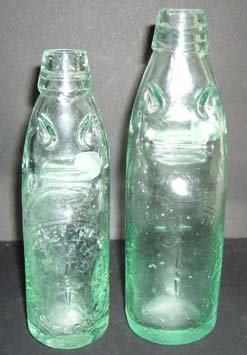
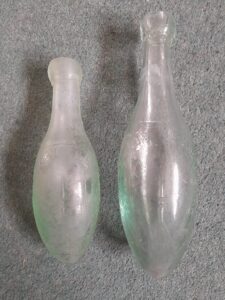
Next is a codd marked “WOBURN SANDS AERATED WATER COMPANY” with a J W Dobson, Barnsley Maker mark. The text is written vertically around the bottle. Also codds marked “BEDFORD & WOBURN SANDS AERATED WATER COMPANY”, and a J. W. Dobson makers mark. These must have come later, after they opened their depot at Bedford. Both variations have “D&N” on the base. The “Bedford…” one comes in large and small sizes.
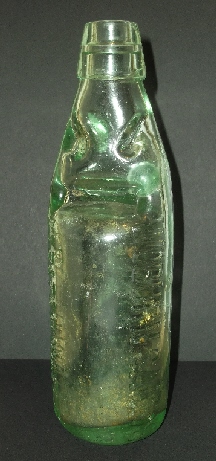
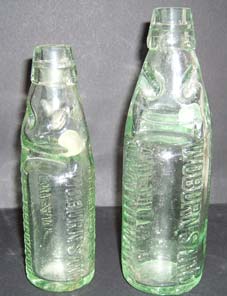
They had opened their Bedford factory by 17th July, 1897, as this appeared in the Beds Times, under the headline “What an electric motor can do”:
“Messrs. Down & Needham, manufacturers of aerated waters, work their machinery at the Bridge Hall, St. Mary’s, with a 3 horse-power motor, which is probably the only one in Bedford. It does not stand more than 15in. high, and weighs under hundredweight. There is no noise, dust, fuel, or delay in getting it to work, and it can run at any speed. It works all day and drives six machines for the insignificant wage of 1s 2d. a day. Guided by a few human hands, the machine so operated cleanses 31 dozen of bottles at once, and remove the old labels, besides filling syphons and bottles with about a dozen different beverages, as required. There is a very pretty set of machinery on the premises. Bottles are automatically filled and stopped with extraordinary rapidity, all are well guarded so that if one flies now and then nobody is hurt: various gauges indicate the pressure; cisterns regulate the supply of syrups as they filter in a purified form from the stores on the upper floor; and an airy and commodious packing-room is a scene of constant activity at this time of the year. Even the stone bottles have the approved screw-stoppers, and the home made ginger-beer is having a good vogue. Orange champagne and ginger stout are among the specialties, and for winter consumption the drinks are Winter Cheer. Nip Nagal, non-intoxicating orange and ginger wines. Messrs. Down and Needham have stores at Rushden, Potton, Dunstable, Woburn Sands, and Bedford.”
Next is a ½ pint internal screw shouldered bottle marked “DOWN & NEEDHAM WOBURN SANDS”. There is an eagle with its wings spread in centre of text. “The Eagle” was the name of their malting building in Russell Street. There is also a version, as above, but the text reads “DOWN & NEEDHAM BRIDGE WORKS BEDFORD”
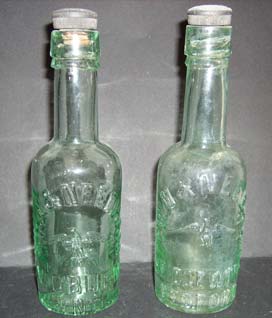
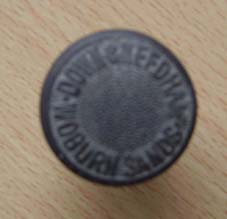
Bridge Works bottles must pre-date 1902, as The Bedfordshire Times & Independent of Friday 8th March, 1901 reported:
THE BRIDGE MINERAL WATER WORKS ST. MARY’S, BEDFORD. Messrs. STAFFORD & ROGERS, Ltd. Have been instructed by Messrs. Down and Needham, who are relinquishing this branch of their business, to Sell by Auction, on Tuesday, March 12th, 1901, at 11 o’clock punctually, The Whole of the Highly Valuable and nearly New PLANT and MACHINERY, by Riley, including a Patent Screw-Thumb Stopper Machine, fitted with 2 oz. syrup pump, a Syphon-filling Machine with guard; one No. 3 Patent Safety Generator complete; 3 in. Soda Water Machine with 14 gall. copper, cylinder, Ioose driving pullies, &c , complete: 2 Vauxhall Codds Filling Machines complete; Patent Rotary Washing Machine, 22 doz. size, double brush heads and two 1 doz. rinsers; a 12 doz. Barnett and Foster’s Rotary Washing Machine; a 2½ in. Barnett and Foster’s Soda Water Machine, with copper cylinder, &c., complete Barnett and Foster’s Copper Gasometer; Galloway’s Horizontal Gas Generator complete; Syrup Supply Pans. Slate Solution Tanks, Cisterns, Corking and Bottling Machines, Capsuling Machine: the 3-h.p. ELECTRIC MOTOR, recently laid down, with accumulating coils, &c., complete, by Davis, No. F. 2; 3 cases of Kola Hop Bitters; 3 Capital SPRING VANS, Office Furniture and Fittings, Fire Proof Safe, &c., together with the excellent and nearly new HOUSEHOLD FURNITURE, comprising superior Wilton Pile and Axminster Carpets, rugs, fender kerbs, implements, large mirrors, a high-class Dining Room Suite in saddlebags, single and easy chairs, walnut telescope, dining, fancy, and occasional tables, very superior 6lt. Dark Oak Sideboard, splendidly fitted; 6¾ -oct. Cottage Pianoforte, by Broadwood; quantity of Cutlery, plated Goods. China and Glass; Bedroom Appointments, Kitchen Requisites, &c.
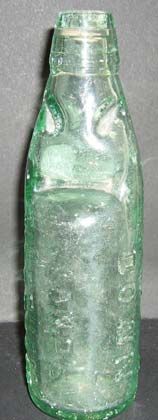
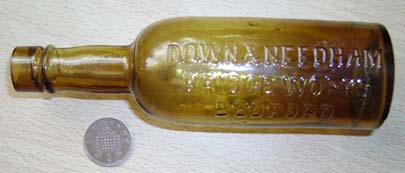
The “DOWN & NEEDHAM BRIDGE WORKS BEDFORD” name also appears on the above codd bottle with a “D&N, TT&Co Ltd” on the base and the same wording appears on a miniature brown spirits bottle.
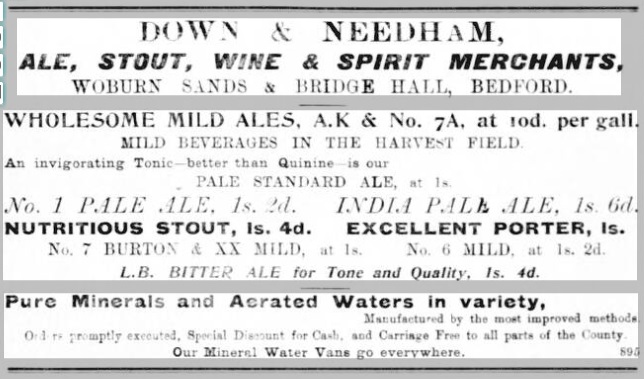
Lastly from Messrs. Down and Needham, there are pint and ½ pint internal screw shouldered bottles marked “DOWN & NEEDHAM BEDFORD & WOBURN SANDS”, with the text vertically around the bottle.
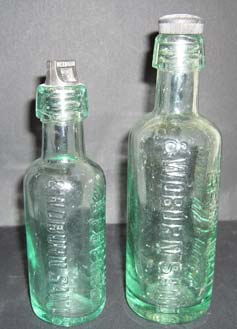
Other Woburn Sands Firms
The other local firms who used embossed or etched bottles for advertising were few and far between. There are ½ pint internal screw clear bottles marked “J. BELLAMY, WOBURN SANDS” with the number “375” or “J.L&Co- C” on the base. I have not discovered who J. Bellamy was. The only J. Bellamy on the 1901 census was listed as a ‘Brick Burner’. By the style of the bottle, it looks like a grocers shop perhaps? A John Bellamy appears on an auction poster in 1903, when two houses near the railway station that were let to him were being sold.
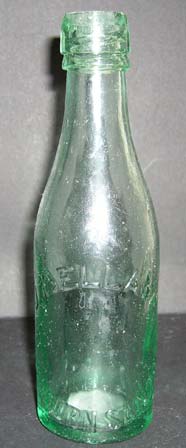
This very nice blue soda siphon is etched “HORTON AND BAYES PHARMACEUTICAL AERATED WATERS – IMPROVED SYSTEM – WOBURN SANDS”. I have another example of the metal top, which the shop owners also had stamped with their details.
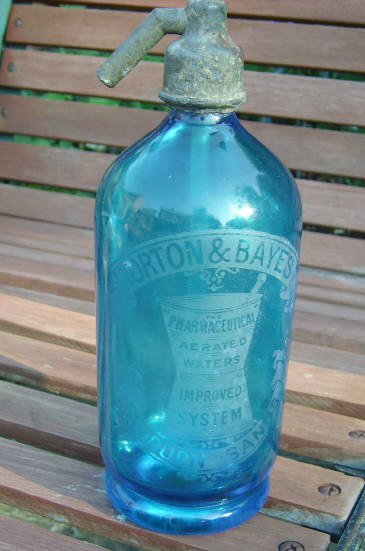
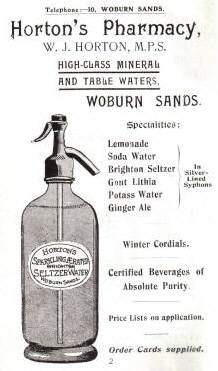
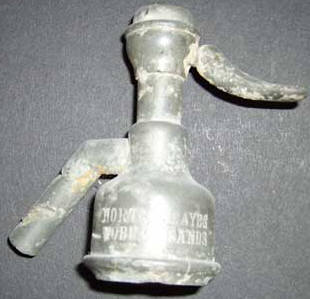
Horton and Bayes were the chemists in the same shop that remained a chemist for many years until 2017. This siphon was dug up in Aspley Heath in 2011. Horton and Bayes sold out to Mr. Bathurst in 1906, so as this could possibly have been in the ground for 115+ years, it has survived remarkably well!
I have two examples of stoneware hot water bottle, both transfer-printed with “GEO. TANSLEY, IRONMONGER, WOBURN SANDS”. The Tansley’s had many business premises in the High Street over the years, and also dealt in decorative china etc.
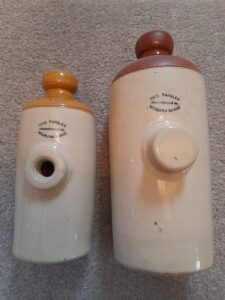
Woburn Sands Milk Bottles
Some printed and acid-etched milk bottles make a change from all the embossed glassware.
There is a newspaper advert in March 1952, showing C. C. Green was in receivership, and that 150 lots of surplus groceries were being sold off.
Information from Mr E. Woods: “The C.C. Green bottle is pre-1950 as it was this dairy that became the Haines Land Farm Dairy of 24-26 Aspley Hill that my parents owned and ran. Mr Green went bankrupt but the property was owned by Mr Cecil Curtis of Great Brickhill, who was my uncle. Cecil also owned Haines Farm in Great Brickhill which is the reason for the name.”
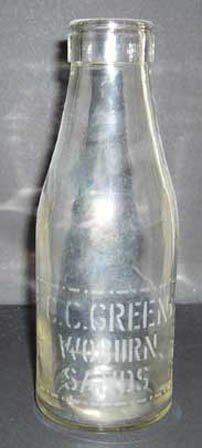
A One-pint and 1/3 pint from Mr. Baker, who also sold ice-creams from a cycle and sidecar unit. They had premises at 60-62 Station Road, but the only newspaper mention I can find relates to a lorry crashing into their shop window in September 1929!
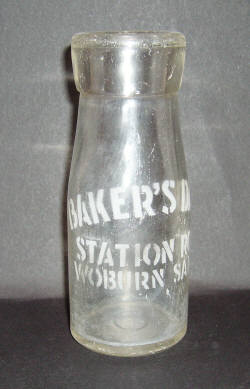
Another small one, acid etched. I cannot find any trace of Mr. Dancer’s Dairy.
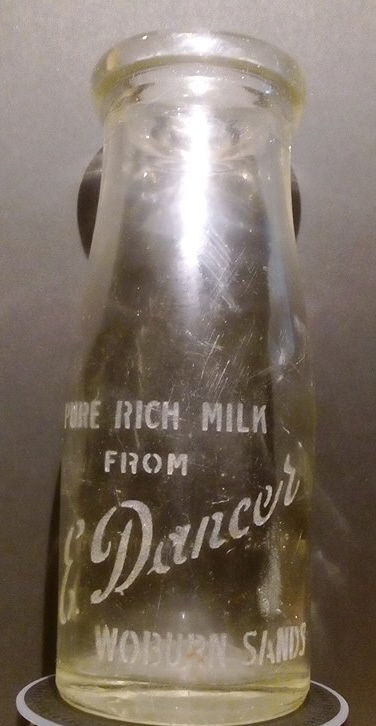
A full pint size, printed. Mr. Considine lived in Hardwick Place and farmed Edgewick Farm in the 1950’s.
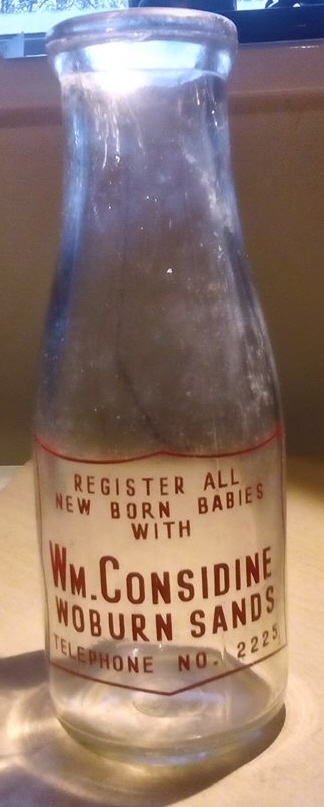
Whole pint, but half the print is worn away. This is from 1950-60’s before the farm was sold to the Menday family.
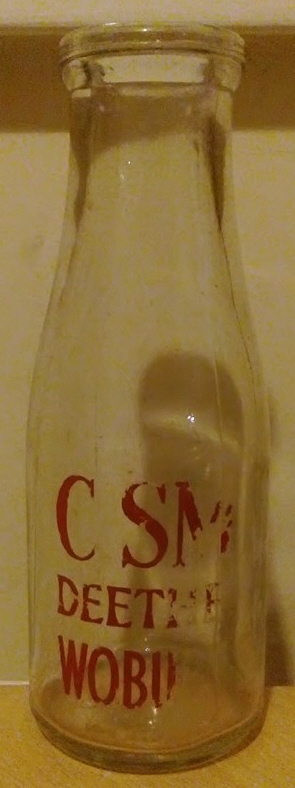
Mr E. Woods: “My parents Reg & Wyn Woods took over the shop and dairy in 1952 and continued until they sold it to Dennis Farmer in about 1964. Haines Land Farm Dairy was at 24-26 Aspley Hill, Woburn Sands. This was not on bottle, as the Farm was in Great Brickhill. We bottled it at Aspley Hill in the days before pasteurization!” I am still looking for one of these for my collection.
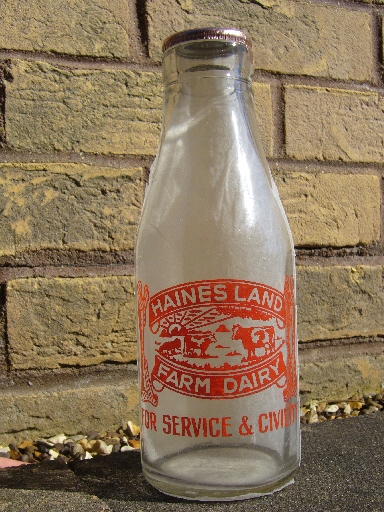
Another I am still looking for…. can you help locate a bottle with “Aspley Hill Dairy” on?
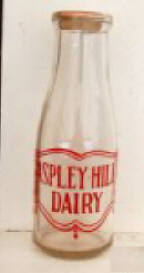
Labelled Woburn Sands Bottles
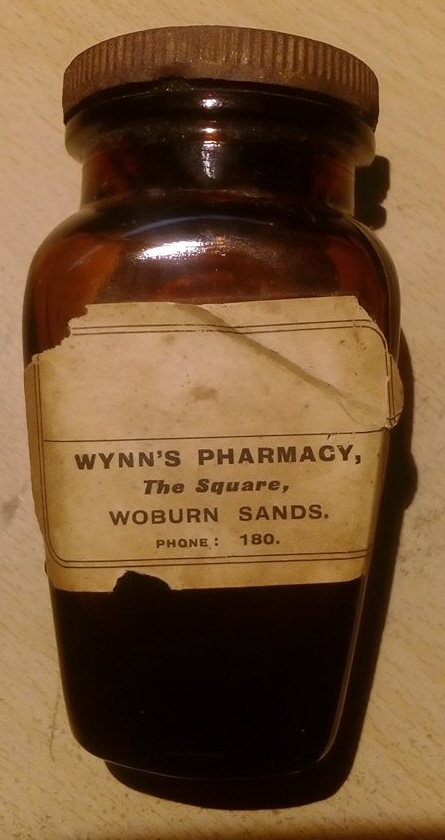
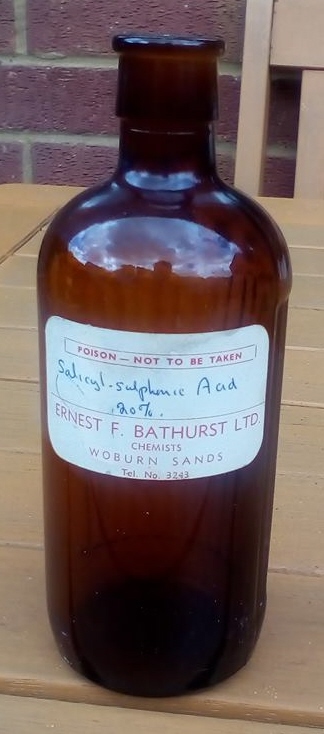
Other local villages
There are at least three flagons for Woburn:
A 1/4 gallon in size, marked “J BARR BEDFORD ARMS WOBURN” with a Doulton & Watts potters mark. Barr was at the Bedford Arms between 1861 and 1867.
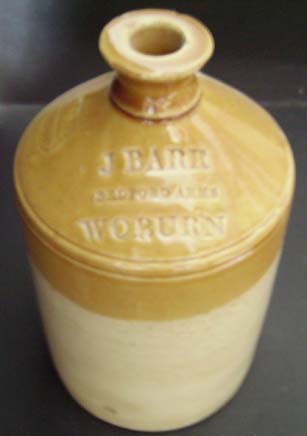
A 2 gallon flagon, marked EDWD. HEIGHINGTON WINE & SPIRIT MERCHANTS WOBURN BEDS could be quite early, as he was running adverts in the Northants Mercury in June 1834, selling J. T. Betts Brandy at 18s. per Imperial Gallon. Edward died 1859. The Heighington family held many trades and positions in Woburn for decades.
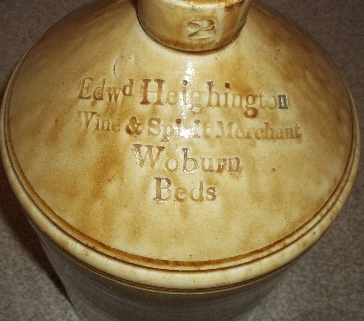
A 1 gallon flagon, reading T. PUDDEPHATT WINE & SPIRIT MERCHANT BEDFORD ARMS WOBURN He also drove the Duke of Bedford’s coach on some occasions. Thomas Puddephatt ran the Bedford Arms after John Barr, until 1901. He had previously run the Queen’s Inn at Luton.
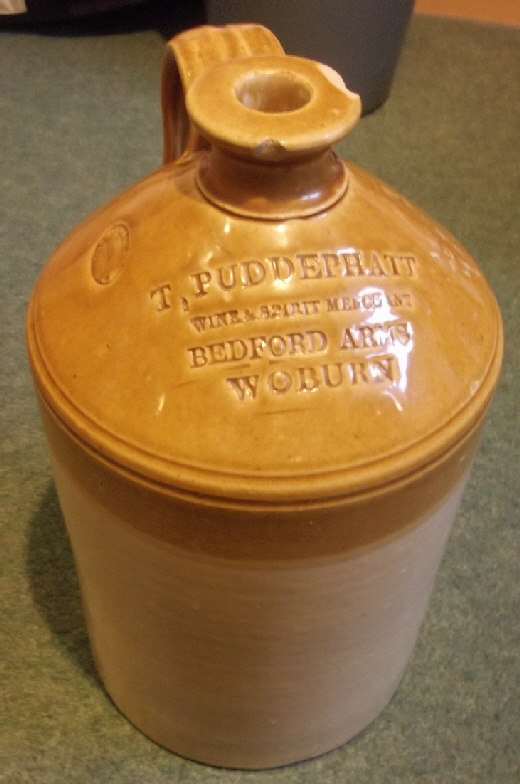
Lastly, there is one flagon for Wavendon, one gallon in size, marked “GEO. E. KING PRIMROSE VILLA WAVENDON BLETCHLEY”, with a Doulton potters mark. Primrose Villa is a few doors up from the ex-Leathern Bottel pub, now The Wavendon Arms. The King family were brewers and farmers in Wavendon for many generations.
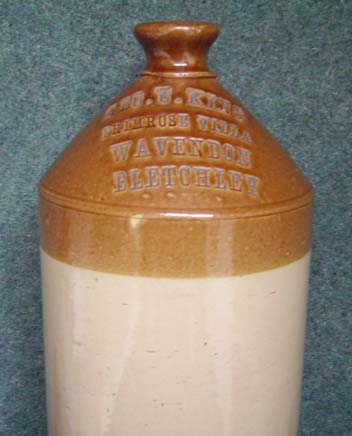
Aspley Guise
This bottle is probably connected to Aspley Guise, as there is also an area called Aspley in Nottinghamshire, but Goodall is a local Woburn Sands name, and had connections to The Royal Oak in Aspley Heath, and also a bakers shop in Aspley Guise, and a baker would be an ideal person to be making Ginger Beer…
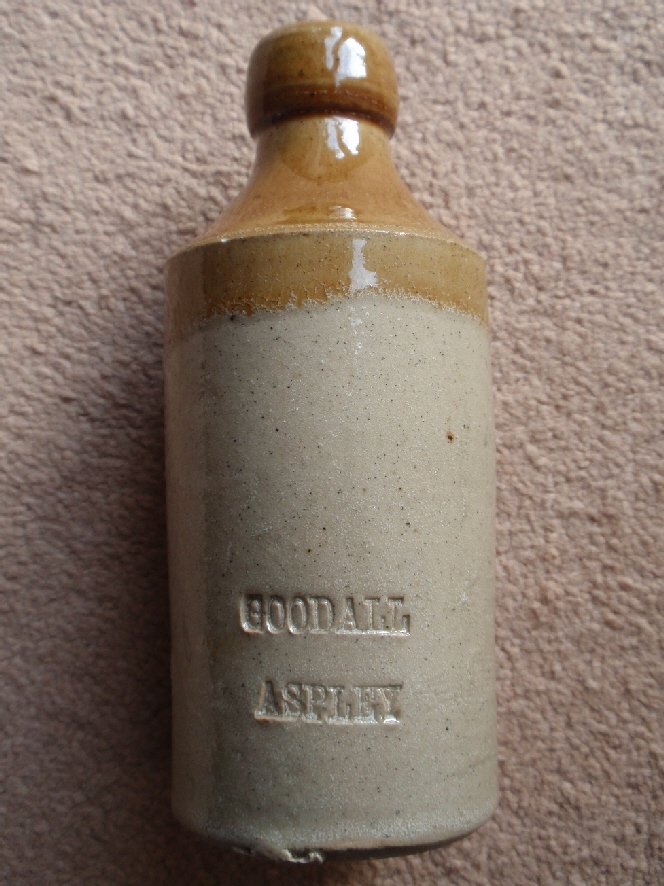
If you have any examples of local bottles not listed here, please let me know.
I also have an interest in flagons from the other old towns in modern Milton Keynes, e.g. Newport Pagnell, Wolverton, Stony Stratford, Olney, Bletchley, Fenny Stratford etc. All my research about these can be found here.
Page last updated Aug. 2022.
